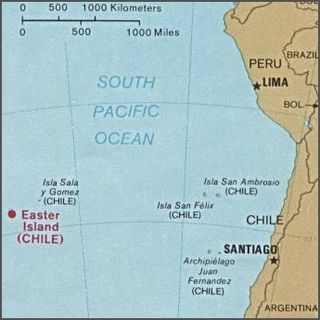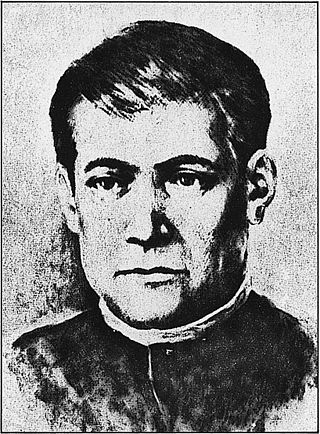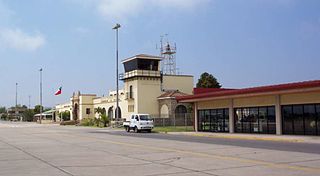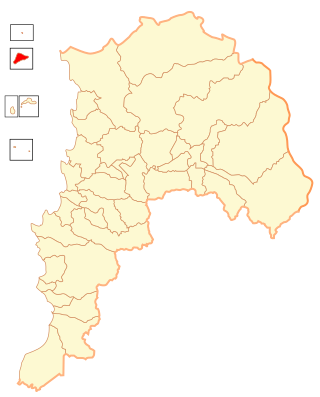
Easter Island is an island and special territory of Chile in the southeastern Pacific Ocean, at the southeasternmost point of the Polynesian Triangle in Oceania. The island is most famous for its nearly 1,000 extant monumental statues, called moai, which were created by the early Rapa Nui people. In 1995, UNESCO named Easter Island a World Heritage Site, with much of the island protected within Rapa Nui National Park.

Hanga Roa is the main town, harbour and seat of Easter Island, a municipality of Chile. It is located in the southern part of the island's west coast, in the lowlands between the extinct volcanoes of Terevaka and Rano Kau.

Motu Nui is the largest of three islets just south of Easter Island and is the westernmost place in Chile. All three islets have seabirds, but Motu Nui was also an essential location for the Tangata manu cult which was the island religion between the moai era and the Christian era. Motu Nui is the summit of a large volcanic mountain which rises over 2,000 meters from the sea bed. It measures 3.9 hectares in land area and is the largest of the five satellite islets of Easter island. It is one of three islands that is closest to Point Nemo, the place in the ocean that is farthest from land, the other two being Ducie Island, one of the Pitcairn Islands, and Maher Island in Antarctica.
The Williamson-Balfour Company was a Scottish owned Chilean company. Its successor company, Williamson Balfour Motors S.A., is a subsidiary of the British company Inchcape plc.

Ma'unga Terevaka is the largest, tallest and youngest of three main extinct volcanoes that form Easter Island. Several smaller volcanic cones and craters dot its slopes, including a crater hosting one of the island's three lakes, Rano Aroi.

Maunga Puna Pau is a small crater or cinder cone and prehistoric quarry on the outskirts of Hanga Roa in the south west of Easter Island. Puna Pau gives its name to one of the seven regions of the Rapa Nui National Park.

Geologically one of the youngest inhabited territories on Earth, Easter Island, located in the mid-Pacific Ocean, was, for most of its history, one of the most isolated. Its inhabitants, the Rapa Nui, have endured famines, epidemics of disease, civil war, environmental collapse, slave raids, various colonial contacts, and have seen their population crash on more than one occasion. The ensuing cultural legacy has brought the island notoriety out of proportion to the number of its inhabitants.

The Tahai Ceremonial Complex is an archaeological site on Rapa Nui in Chilean Polynesia. Restored in 1974 by American archaeologist William Mulloy, Tahai comprises three principal ahu from north to south: Ko Te Riku, Tahai, and Vai Ure. Visible in the distance from Tahai are two restored ahu at Hanga Kio'e, projects that Mulloy undertook in 1972. Like other Mulloy restoration projects at Ahu Akivi, the ceremonial village of Orongo and Vinapu, the ceremonial center at Tahai now constitutes an integral part of the Rapa Nui National Park, designated by UNESCO as a World Heritage site.

Text S of the rongorongo corpus, the larger of two tablets in Washington and therefore also known as the Great or Large Washington tablet, is one of two dozen surviving rongorongo texts.

Eugène Eyraud was a lay friar of the Congregation of the Sacred Hearts of Jesus and Mary and the first Westerner to live on Easter Island.

La Florida Airport is an airport serving La Serena, a Pacific coastal city in the Coquimbo Region of Chile.

CF Rapa Nui is an association football team from Chile which represents the territory of Easter Island in association football. Their home games are played at the Estadio de Hanga Roa, which has a capacity of approximately 2,500 people.
Hotel Hanga Roa, also known as Hanga Roa Eco Village & Spa, as of 2020 branded as Nayara Hangaroa, is a hotel in Hanga Roa, Easter Island, overlooking the bay on the Avenue Pont. The hotel was used extensively in the 1994 film Rapa Nui. In 1994, the hotel was purchased by the Panamericana hotel firm who extended the property with 10 fake thatched roofed bungalows, nine of which have three rooms. The 60 other rooms are located in the main building. Later, the hotel was acquired by Tanica hotels, owned by the Schliess family from mainland Chile. The Hito family, an extended family from Easter Island, occupied the premises for six months in 2010, claiming ancestral property rights. The hotel closed in 2011 for refurbishment and was projected to include a new museum and theatre, shopping complex, pool, tennis courts and other rooms. The hotel staff were mainly Rapa Nui locals, but the management was not from Easter Island. After a protracted conflict between the Hito family and the Schliess family, an agreement was reached in 2020. Under the agreement, property rights were transferred to the Hito family while the Tanica hotel group retained the right to exploit the hotel for 15 years. In 2020 the Costa Rican Nayara Resort group took control of the marketing.

The Mana Expedition to Easter Island occurred between March 1913 and August 1915. It was the first archaeological expedition to Rapa Nui which was privately organized and funded, preceding the Norwegian Archaeological Expedition to Easter Island of Thor Heyerdahl by more than 40 years. The Mana Expedition was led by Katherine and William Scoresby Routledge. The expedition and its ship, the Mana, bore the same name. The ship left Falmouth, England on 13 March 1913 with a crew of twelve, including a surveyor, geologist, sailing master, navigator, engineer, cook, seamen, a cabin boy and the Routledges. They arrived on the southern coast of the island at Hanga Roa Bay, by way of the Strait of Magellan, on 29 March 1914, setting up their first camp at Mataveri, on the island's southwest corner. The English archaeologist O. G. S. Crawford referred to the expedition as "an archaeological fiasco".

The Holy Cross Church, also known as the Catholic Church of Hanga Roa, or simply the Hanga Roa Church is a Catholic Church in Te Pito Te Henua Street in the city of Hanga Roa, the capital and greater city of the Easter Island, a Territory of Chile in the Pacific Ocean. The church was established in 1937, its first priest being Father Sebástian Englert.

Angata, full name María Angata Veri Tahi ʻa Pengo Hare Koho was a Roman Catholic Rapa Nui religious leader from Easter Island during the late 19th and early 20th century. After experiencing a prophetic vision in which God instructed her to retake the land and livestock, she led an unsuccessful rebellion on the island against the Williamson-Balfour Company, intending to create a theocracy centered on Roman Catholicism and Rapa Nui spiritual values.

Pu o Hiro is a stone on Easter Island that was used as a musical instrument by the ancient Rapa Nui. It is also known as Maea Puhi. When blown through its main hole, it would produce a sound that resembled a trumpet. It was used to invoke Hiro, the deity of rain.

Isla de Pascua Province is a Chilean province, an administrative division located within the Valparaíso Region. It has a 163.6 km² area and a population of 5761 inhabitants. The provincial capital is Hanga Roa. Besides Easter Island, the province comprises the small and uninhabited Isla Salas y Gómez, located hundreds of kilometers east of Easter Island. It is the only Chilean province located in Oceania and has a "special regime" status, with similar attributions to regional governments. It was created in 1976, replacing the former Isla de Pascua Department.

Isla de Pascua is a Chilean commune with a special regime, located within Isla de Pascua Province in Valparaíso Region. It is the only commune in Isla de Pascua Province, comprising Easter Island and Isla Salas y Gómez. Its capital is Hanga Roa, located in the southwestern area of the main island, where most of the local population resides.

Isla de Pascua Department, also named Easter Island Department, was one of the departments of the historical province of Valparaíso before the "regionalization" of 1974. It was named after Easter Island and comprised such territory and the Sala y Gómez island. It was effectively replaced in 1976 by the Isla de Pascua Province.




















